Looking to create VR content without breaking the bank? Here are 7 free, open-source tools to get you started:
- A-Frame: Web-based VR framework
- UltimateXR: Unity-based VR development toolkit
- VR Builder: No-code VR creation for Unity
- OpenXR SDK: Cross-platform VR/AR development API
- Jahshaka: 3D modeling and VR scene builder
- Open Brush: VR painting and 3D art tool
- Qualisys: Motion capture for Unity (not open-source)
Quick comparison:
| Tool | Best For | Ease of Use | Key Feature |
|---|---|---|---|
| A-Frame | Web developers | Easy | WebVR creation |
| UltimakeXR | Unity devs | Moderate | Cross-device support |
| VR Builder | Non-coders | Easy | Visual workflow |
| OpenXR SDK | Advanced devs | Moderate | Hardware compatibility |
| Jahshaka | 3D artists | Moderate | Asset management |
| Open Brush | VR artists | Easy | 3D painting |
| Qualisys | Animators | Moderate | Motion capture |
These tools let you create VR experiences for multiple devices without expensive software. Pick based on your skills and project needs.
Related video from YouTube
1. A-Frame
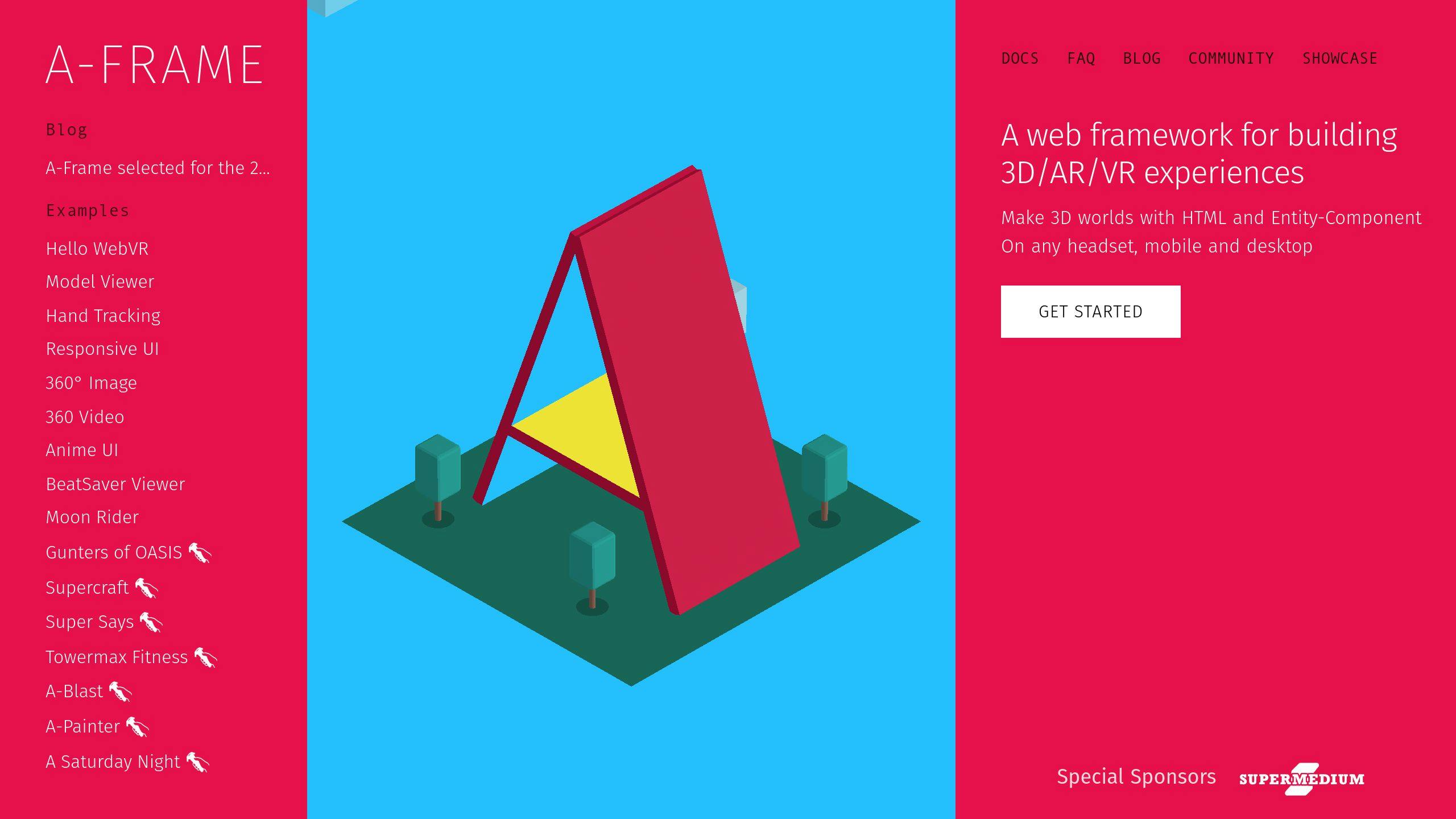
A-Frame is a free, open-source web framework for building VR experiences. It's perfect for web developers, designers, and even beginners who want to dive into VR creation.
What A-Frame can do
With A-Frame, you can create:
- 360° images and videos
- 3D environments
- WebVR experiences
- Hand tracking features
It uses HTML-like syntax, so web developers feel right at home. Here's a simple 3D scene in just a few lines:
<a-scene>
<a-box color="grey" depth="2" height="2" width="2" position="0 2 -4" rotation="45 45 45"></a-box>
<a-sky color="green"></a-sky>
</a-scene>
This code gives you a gray cube and a green sky. Easy, right?
Devices that work with A-Frame
A-Frame plays nice with:
- VR headsets (Oculus Quest, HTC Vive, Windows Mixed Reality)
- Mobile VR (Google Cardboard, Samsung Gear VR, Google Daydream)
- Desktop browsers
- Mobile phones and tablets
So, your A-Frame project can reach pretty much anyone, anywhere.
How easy is it to use?
A-Frame is built to be user-friendly:
- It uses familiar HTML
- There's detailed documentation and a free course
- You can get help on Slack, GitHub, or Stack Overflow
- It has a built-in inspector for real-time tweaks
"A-Frame is super easy to build in. It makes use of declarative HTML." - Mel, eLearning Industry
Real-world A-Frame projects
Big names have used A-Frame to create some cool stuff:
- Supermedium's "Moon Rider": A VR music game in space
- CERN's "CMS / LHC Tour": A 360° tour of the Large Hadron Collider
- NASA and Google's "Access Mars": Explore Mars using Curiosity rover data
- Mozilla's "Hubs": A VR chat platform
These projects show how versatile A-Frame can be, from games to educational tours and social platforms.
2. UltimateXR
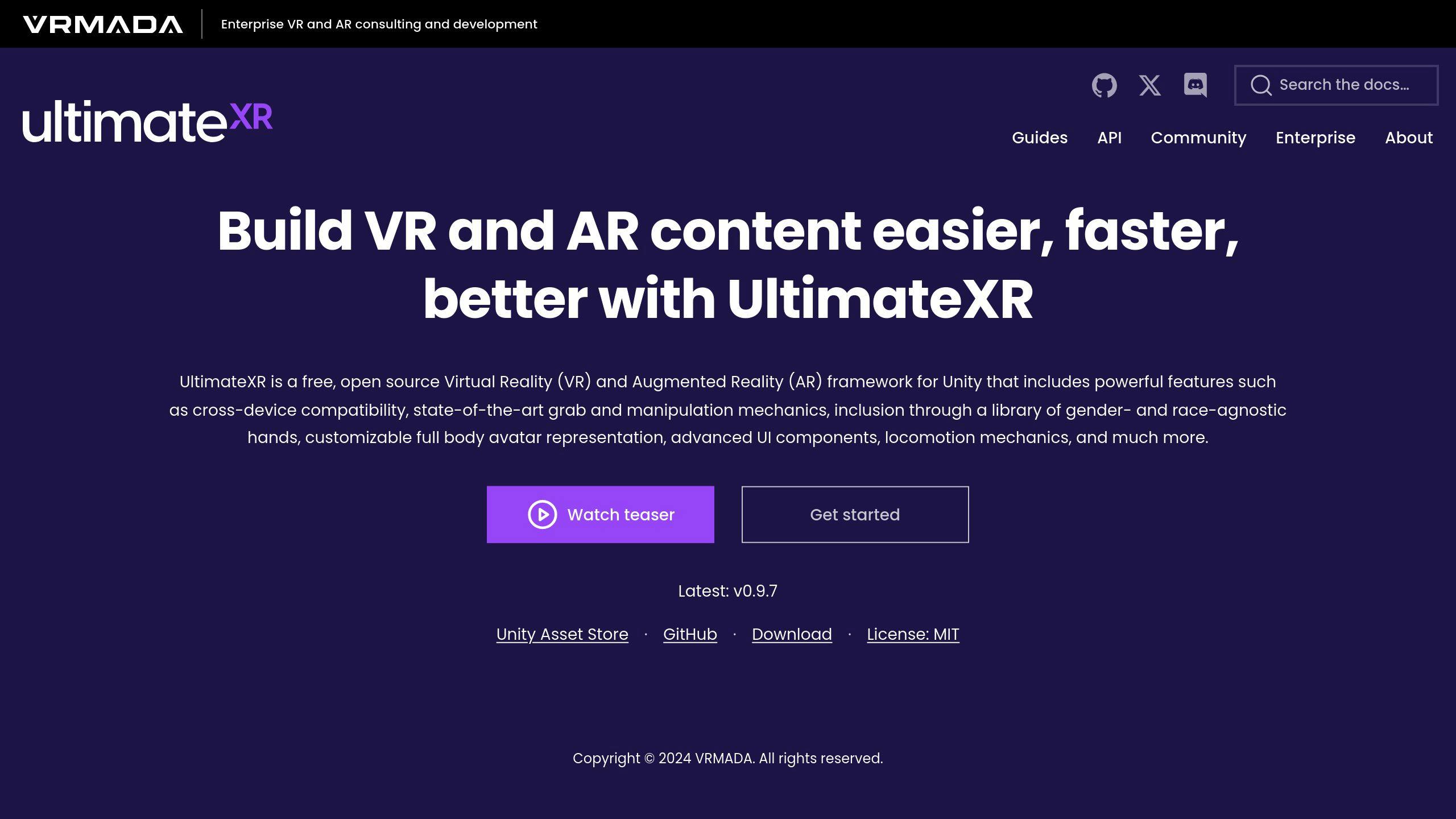
UltimateXR is a free, open-source Unity framework for VR app development. It's packed with tools to build immersive experiences.
Key Features
UltimateXR offers:
- Cross-device support
- Grab and manipulation tools
- Avatar customization
- Advanced UI elements
- Various locomotion options
It's compatible with all Unity 3D rendering pipelines, including Universal and High-Definition.
Supported VR Devices
UltimateXR works with major VR headsets and SDKs:
- Meta Quest
- Pico XR
- SteamVR
- WaveXR
- Windows Mixed Reality
This broad support makes it ideal for developers targeting multiple VR platforms.
User-Friendly and Community-Driven
UltimateXR prioritizes ease of use:
- Comprehensive documentation
- Full example scene for quick starts
- Active community contributions
Enrique Tromp, VRMADA's Co-Founder and CTO, explains:
"We released it for free and open-source because we are passionate about our work and love the idea of sharing it with the world."
This open approach fuels ongoing toolkit improvements.
Industry Applications
UltimateXR serves various sectors:
- Training: Immersive corporate scenarios
- Collaboration: Virtual meeting spaces
- Gaming: Interactive VR experiences
Its flexibility suits both indie developers and large companies entering VR development.
3. VR Builder

VR Builder is a free Unity plug-in that makes VR development a breeze. It's open-source and works for both coders and designers.
What VR Builder can do
VR Builder's got some cool tricks up its sleeve:
- Drag-and-drop workflow creation
- Visual tools for VR interactions
- Built-in text-to-speech
- Easy teleportation setup
- Library of common VR actions
These features help you spend less time coding and more time creating awesome VR experiences.
How easy it is to use
VR Builder is all about keeping things simple. Its visual interface means you don't need to be a coding wizard to create VR workflows. It's perfect for teams with mixed skill levels.
If you're already using Unity, VR Builder fits right in. It works with Unity 2021.3 and up, so you're good to go with recent versions.
VR systems that work with VR Builder
VR Builder plays nice with lots of VR platforms:
| VR System | Works? |
|---|---|
| Meta Quest | Yep |
| HTC Vive | Yep |
| HP Reverb | Yep |
| Valve Index | Yep |
| Pico | Yep |
| SteamVR | Built-in |
This means you can create for multiple VR platforms without switching tools.
How different industries use VR Builder
VR Builder's flexibility makes it useful in all sorts of fields:
1. Construction
A big construction company used VR Builder to make safety training more engaging. They created VR simulations for risky situations like working at heights and dealing with faulty machinery. The result? A 40% drop in workplace accidents in just one year.
2. Education
The Info Box feature in VR Builder's UI Add-On is a hit in educational VR. It provides info boxes that guide users through complex topics, making learning in VR more interactive and fun.
3. Product Development
Companies are using VR Builder to create product demos. It's great for quickly prototyping VR experiences, helping product teams visualize and test designs before production.
4. Corporate Training
The Multiple Choice Box feature is spicing up corporate training. It allows for immersive VR quizzes and exams, adding a new dimension to learning programs.
VR Builder's open-source nature and active community mean it's always improving. If you're into VR development, it's definitely worth checking out.
4. OpenXR SDK
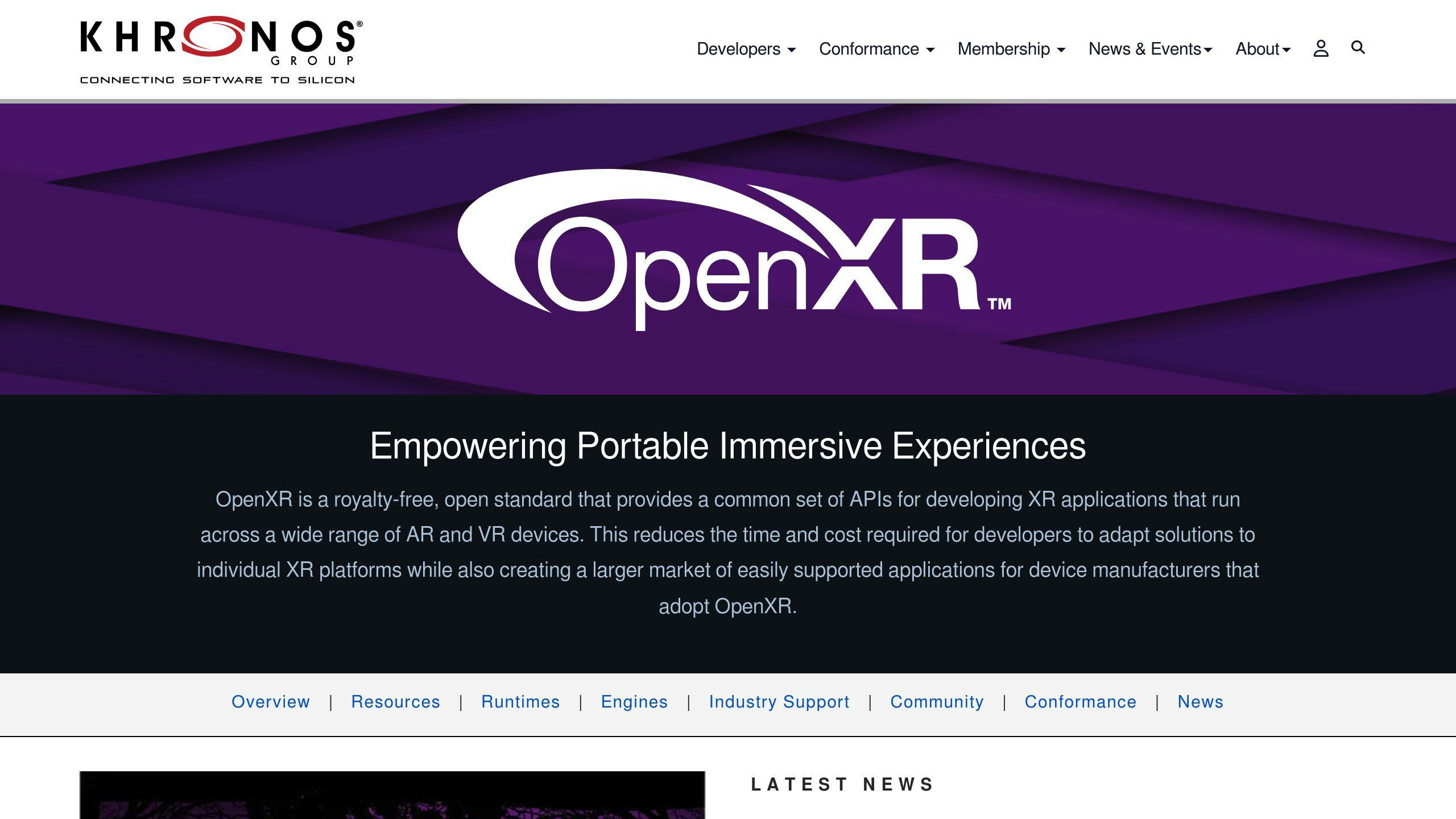
OpenXR SDK is a free, open-source tool for creating VR and AR apps that work across devices. Think of it as a universal translator for XR hardware and software.
What OpenXR can do
OpenXR simplifies XR development:
- Build once, run everywhere
- Works with many VR and AR devices
- Ensures smooth experiences across platforms
- Reduces the need to learn multiple APIs
Devices that work with OpenXR
OpenXR supports various XR devices:
| Company | Devices |
|---|---|
| Varjo | XR-3, VR-3, Aero, XR-4 |
| Magic Leap | Magic Leap 2.0 |
| Sony | ELF-SR1, ELF-SR2 |
| Meta | Quest Pro, Quest 3, Quest 2 |
| HTC | VIVE Streaming, XR Elite, Focus 3 |
| Canon | MREAL Display series |
How to use OpenXR in development
Getting started with OpenXR:
1. Set up your environment
Use a Windows or Linux PC, install Visual Studio 2017+ (Windows) or Android Studio, and have XR hardware ready.
2. Include OpenXR in your project
Add the OpenXR loader or use the official NuGet package.
3. Configure your project
Select OpenXR as the XR plugin and add interaction profiles for your target controllers.
4. Start developing
Use OpenXR's API functions (they start with xr) and check out openxr-tutorial.com for practice.
Community involvement with OpenXR
The OpenXR community helps improve the standard through:
- Open-source contributions on GitHub
- Conformance testing
- Feedback and feature requests
"The OpenXR specification is a crucial part of the Mixed Reality ecosystem. Where previously application developers had to develop for each XR headset separately using proprietary APIs, they now have the freedom to develop for many different devices at once." - Ron Bessems, OpenXR Working Group Chair and Distinguished Software Engineer at Magic Leap
OpenXR is reshaping XR app development. If you're serious about VR and AR, it's worth exploring.
sbb-itb-bc761f5
5. Jahshaka

Jahshaka is a free, open-source toolkit for creating VR content. It's built to help you make, share, and profit from virtual assets, scenes, and worlds.
What Jahshaka can do
Jahshaka packs a punch with its VR creation tools:
- Real-time VR scene building
- 3D modeling and animation
- Visual effects with particle systems
- Asset management
- Custom shader support
- Physics engine integration
Plus, it comes with Jahshaka Player for VR playback and Jahshaka Worlds for hosting interactive virtual spaces.
Devices that work with Jahshaka
Jahshaka plays nice with:
| Device/Platform | Works? |
|---|---|
| Oculus Rift | Yep |
| Desktop PCs | Yep |
| Laptops | Yep |
| Mobile devices | Yep |
| 4K displays | You bet |
How easy it is to use and learn
Jahshaka tries to be friendly for newbies and pros alike. It offers:
- Visual scene creation
- Built-in tutorials and docs
- Community forums for help
- Regular updates
The current version (2.0 / VR 0.8.1 Beta) is still a work in progress, aiming to make things even easier.
Examples of Jahshaka projects
While specific examples are scarce, Jahshaka has been put to work in:
- Architectural visualization
- Game development
- Educational simulations
- Virtual art galleries
Its open-source nature (GPLv3 license) means you can use and tweak it for all sorts of VR projects.
6. Open Brush
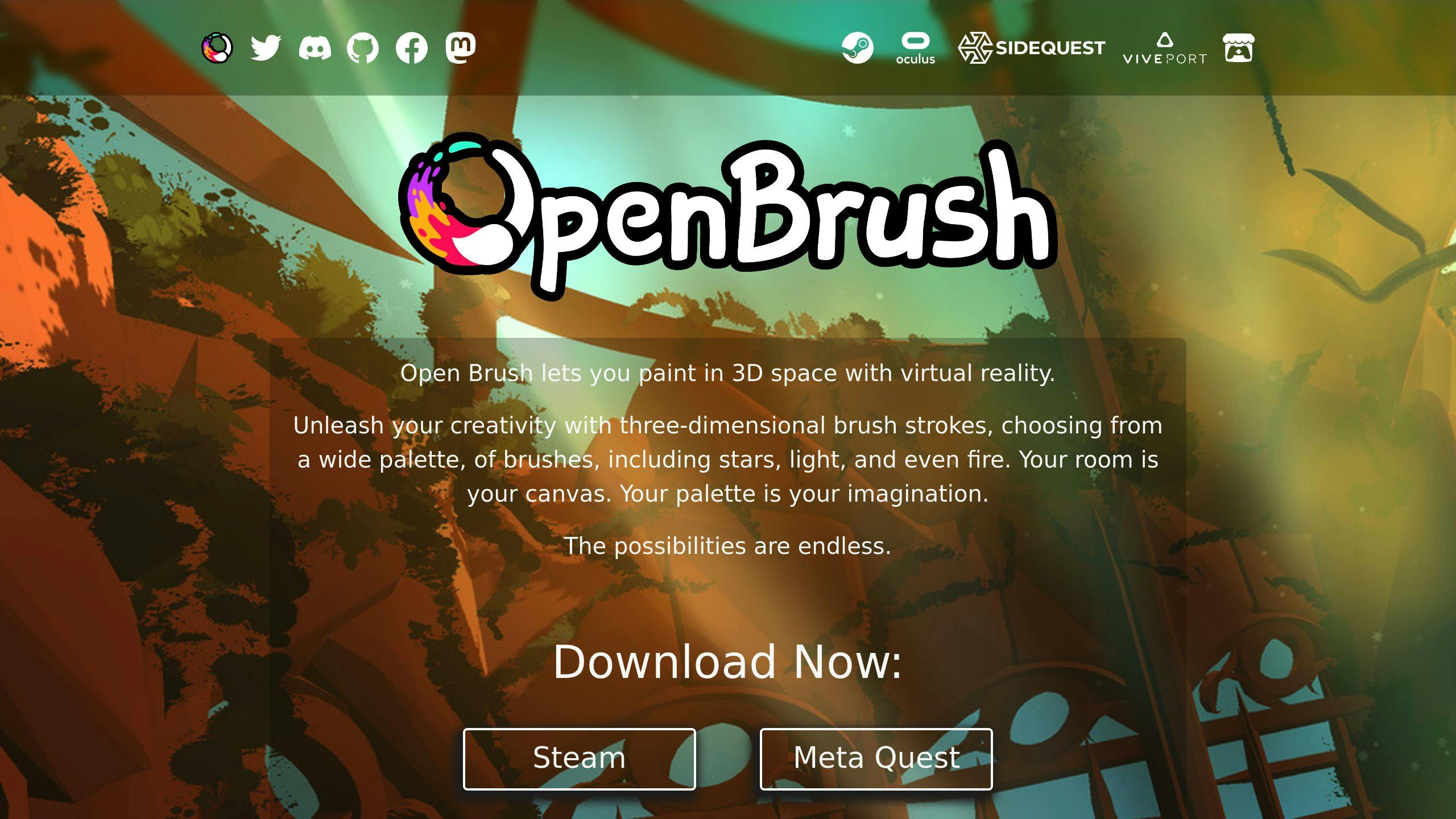
Open Brush is a free VR 3D painting tool that grew out of Google's Tilt Brush. It's for everyone from hobbyists to pro artists.
What Open Brush can do
Open Brush is packed with cool features:
- Paint in 3D virtual spaces
- Use funky brushes (sparkles, fire, bubbles)
- Advanced mode with shape guides and layers
- Fly around your art easily
- Merge sketches
- See the real world while you paint
- Snip and join your strokes
- Import point clouds and WebM videos
VR systems that work with Open Brush
| Platform | Works? |
|---|---|
| Windows | Yes |
| Linux | Yes |
| macOS | Yes |
| Meta Quest | Yes |
| HTC Vive | Yes |
| Oculus Rift | Yes |
| Windows Mixed Reality | Yes |
How to use it
Open Brush is pretty simple:
- Hold the trigger to paint
- Use your other hand for menus
- Tap controllers to switch hands
- Hold buttons for undo/redo
- Grip both controllers to scale/rotate
There's a user guide for the basics, and the community offers support and updates.
What people make with it
Open Brush is used for:
- Virtual art galleries
- 3D concept art
- VR storytelling
One user said: "A 13-year-old made their first artwork in Open Brush in just five minutes."
Plus, it's free for commercial use. That's why all kinds of VR artists love it.
7. Qualisys
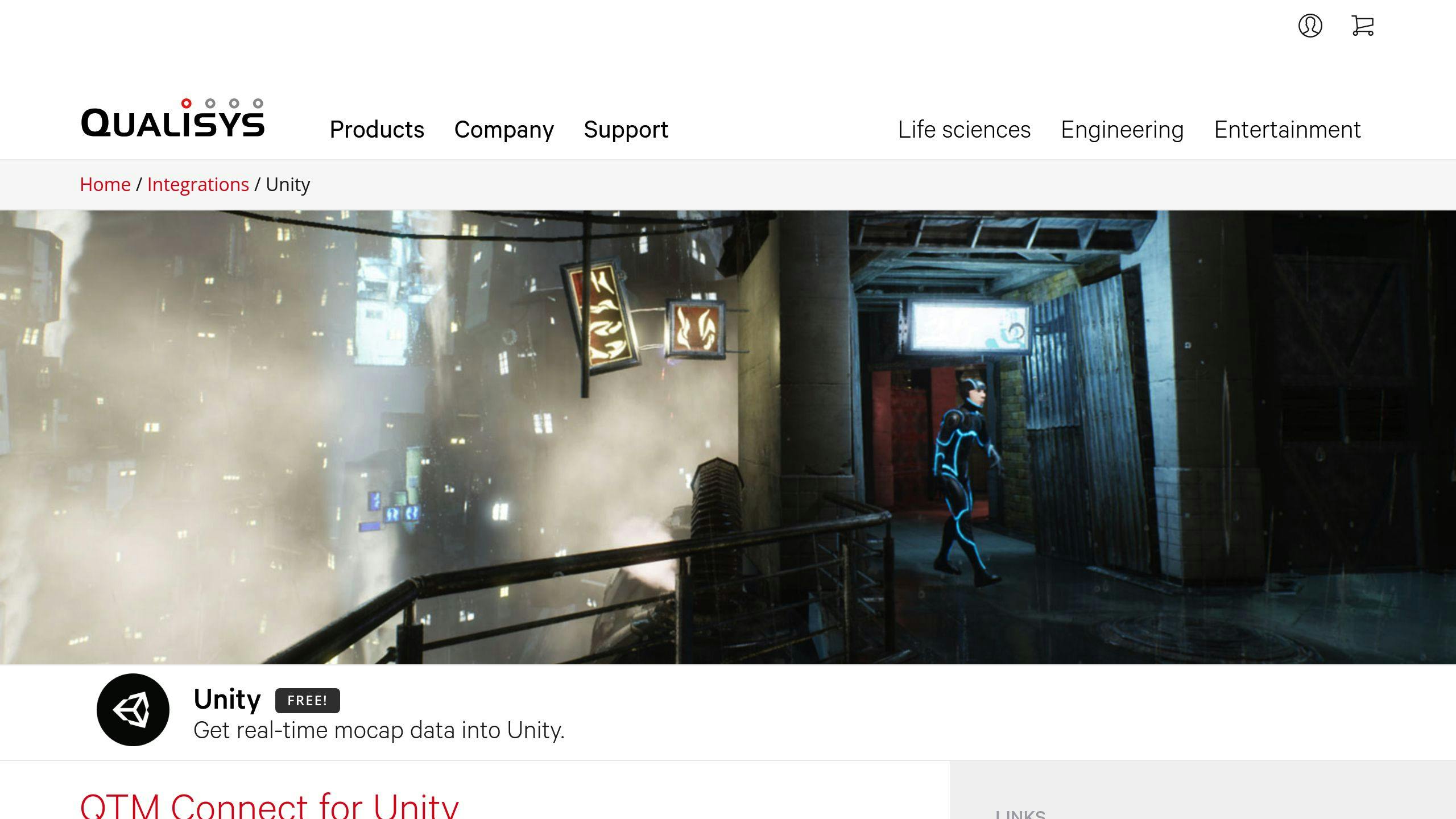
Qualisys is a top-notch motion capture tool for Unity projects. It's not open-source, but it's a game-changer for VR development.
What Qualisys Can Do
Qualisys packs a punch with its Unity motion capture features:
- Streams mocap data in real-time (super fast!)
- Maps Unity's Mecanim bones to QTM segments automatically
- Drives characters, rigid bodies, or any Unity object
- Solves skeletons in real-time for one or more actors
- Handles complex movements like crouching or wrestling
Qualisys-Compatible Systems
| Platform | Works? |
|---|---|
| Unity | Yep |
| Windows | Yep |
| Mac | Yep |
| Linux | Yep |
Using Qualisys with Unity
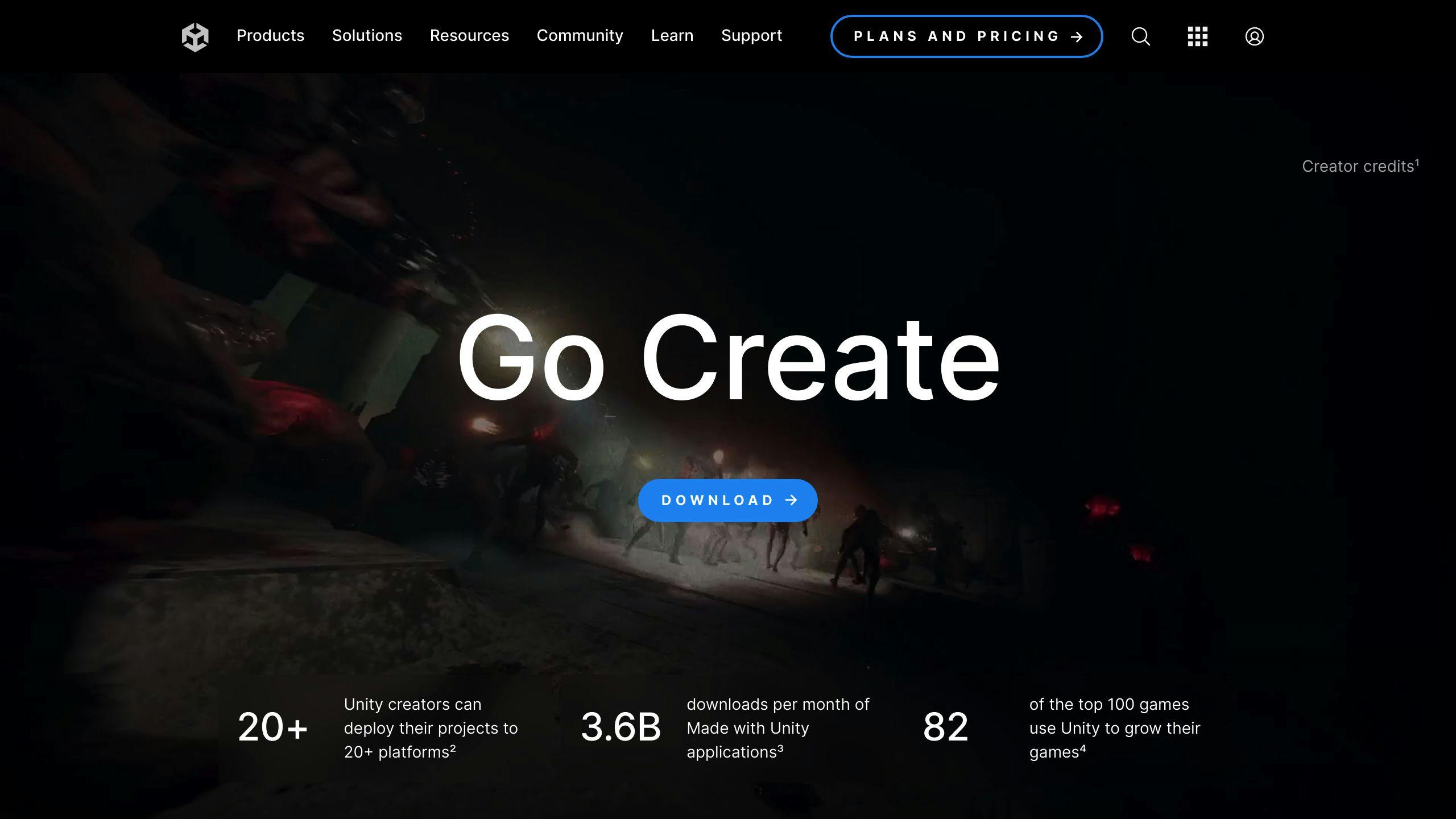
It's a breeze to set up:
- Add the skeleton script to your Unity project
- Set the QTM skeleton's actor name
- Hit play
For rigid body tracking, just:
- Add a script to the GameObject
- Set the QTM rigid body name
Qualisys in Different Industries
Qualisys isn't just for VR. It's used in:
- Gaming: Bringing characters to life
- Film: Creating CGI characters
- Sports: Analyzing athlete performance
- Medical: Studying gait and aiding rehab
While not open-source, Qualisys is a go-to for devs who want top-notch mocap in their VR projects.
Comparing the tools
Let's break down how these 7 open source VR creation tools stack up. We'll look at what they offer, how easy they are to use, and the support you can expect.
Tool comparison table
| Tool | Ease of Use | Key Features | Community Support | Instructions |
|---|---|---|---|---|
| A-Frame | High | WebVR, HTML integration, multi-device | Active | Comprehensive docs |
| UltimateXR | Moderate | Unity integration, multi-platform | Growing | Tutorials available |
| VR Builder | High | User-friendly, cross-platform | Supportive forums | Step-by-step guides |
| OpenXR SDK | Moderate | Unified VR hardware API, cross-platform | Strong industry backing | Detailed API docs |
| Jahshaka | Moderate | Asset management, immersive tools | Active development | User manuals |
| Open Brush | High | VR painting, brush options | Community-driven | Easy tutorials |
| Qualisys | Moderate | Motion capture for Unity | Industry-focused | Technical docs |
A-Frame is your go-to for quick WebVR projects. It's perfect if you're a web dev looking to dip your toes in VR.
UltimateXR and VR Builder are all about Unity. VR Builder is a bit easier to use, so pick based on your Unity skills.
OpenXR SDK is for the tech-savvy devs who want their apps to work across VR platforms. It's powerful, but you'll need some coding chops.
Jahshaka is your Swiss Army knife for immersive content, while Open Brush is all about VR painting.
Qualisys isn't open-source, but it's great for Unity projects that need precise motion tracking.
When picking a tool, think about:
- What does your project need?
- How tech-savvy are you?
- How much help will you need?
For example, if you're new to VR and want to create web stuff, A-Frame's your best bet. But if you're a Unity pro needing VR features, UltimateXR or VR Builder might be better.
Keep in mind, VR tech is always changing. Stay updated on these tools as you work on your projects.
Wrap-up
Open source VR tools are game-changers. They're flexible and cost-effective, but choosing the right one can be tricky.
When picking an open source VR tool, consider:
- Project needs
- Team skills
- Device compatibility
- Community support
The VR world moves fast, so stay updated.
Some quick tips:
- Start with Google Cardboard for low-cost testing
- Use Blender for free, non-commercial projects
- Try SimLab VR's 21-day free trial for no-code VR
Open source tools are driving VR's future. More developers mean more innovation.
Keep an eye on:
- Open source expertise demand in cloud and DevOps
- Open source security focus
- Containers and Kubernetes usage
The VR landscape is evolving. Open source tools are at the forefront, shaping how we create and experience virtual worlds.



